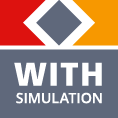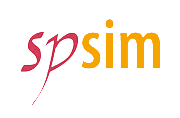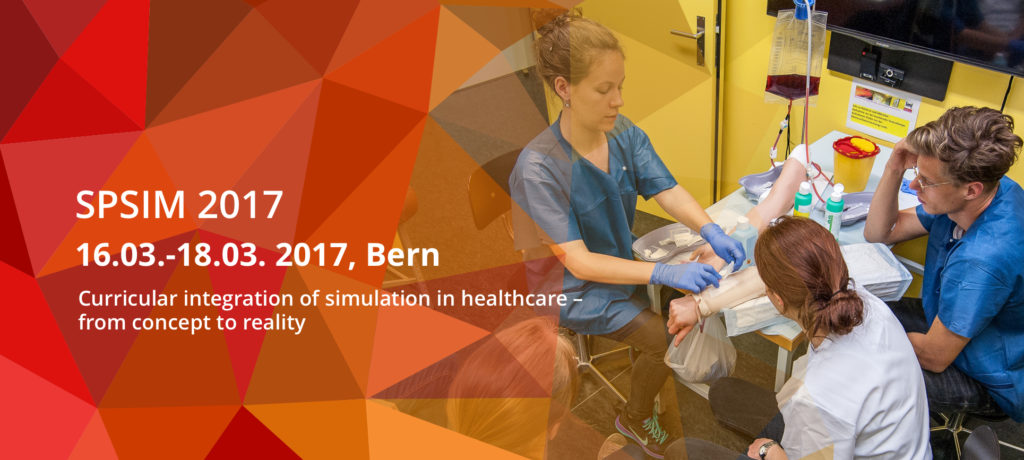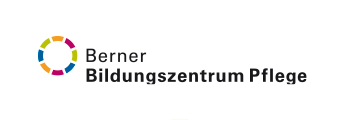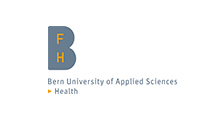| Poster 1-1: Partial Evaluation of an interprofessional simulation based Training |
Sarah Kramer1, Toni Wäfler1, Dorothée Eichenberger2
1Fachhochschule Nordwestschweiz, Switzerland; 2Berner Fachhochschule, Switzerland; sarah.kramer@students.fhnw.ch
Background: Amongst the various forms of education, simulation based trainings are very costly and time-consuming regarding both training design as well as implementation. Nonetheless they are becoming more and more common in medicine and healthcare. In 2013 at the simulation center of the university hospital Bern, an interdisciplinary simulation based training developed for midwifery and anesthesia students was carried out as a pilot for the first time. In the year 2015/2016 it was definitely implemented into the bachelor curricula of midwifery and anesthesia studies. The aim was to enhance the quality and effectiveness of the two disciplines’ interdisciplinary collaboration. This year (2016), the fourth generation of midwifery students participated in the training. During half a day a group of students from both disciplines were confronted with simulations of different scenarios in which the pregnant women or the unborn child went through life-threatening crises. During these simulations some students participated and others observed the scenario from the debriefing room. After each simulation a video-assisted debriefing was provided, facilitated by a senior midwife and senior anesthetist. Against this background the aim of the present study is to measure the midwifery students’ subjective perception of the training’s effectiveness. This measurement is based on Kirkpatrick’s (1994) model of training success . It distinguishes four levels on which success can be measured: 1. Reaction (Did the participants like the training? Did they find it useful?), 2. Learning (Did they learn something?), 3. Behavior (Do they show the desired behavior at work?), and 4. Results (Does the behavior change trigger the intended outcome?). Each lower level of this model is a precondition but not a guarantee for reaching the respective higher level.
Research question: The research question of the study is: What is the midwifery students’ subjective perception regarding Kirkpatrick’s levels reaction, learning and behavior?
Methods: With help of a before- (n = 41) and after- (n = 34) training questionnaire variables from level 1 (perceived usefulness and liking) and 2 (perceived self-efficacy and instrumentality regarding the training) of Kirkpatrick’s evaluation model were measured of the midwifery students who were trained in 2016.
Half-standardized interviews were held with midwifes (n = 5) to measure level 3 (perceived transfer of trained behavior). The midwives interviewed were also from the training cohort 2016. At the time the interviews were held they had completed the theoretical part of their studies and worked in an internship in hospitals.
Results: The majority of the participants found the training very useful and likable The medians (with inter quartile range in parentheses) for usefulness and liking were 6.67 (6.33-7.00) and 6.38 (6.00-7.00), respectively. There was a significant effect for self-efficacy, t (32) = 5.09, p < .001, d= 0.74, 95% CI [0.44, 1.04] and instrumentality, t(33) = 4.95, p < .001, d= 0.74, 95% CI [0.44, 1.04] with higher scores in the post-measurement.
Conclusion: The positive tendency on the indicators measured on level 1 and 2 suggests a certain success of the training. Additionally, the variables measured on level 2 (learning) seem to be promising indicators for level 3 (behavior). Future studies that investigate larger samples (especially for the behavioral measures) and incorporate the aenesthesiologists’ views might further elucidate the role of these indicators regarding the success of simulation based trainings.
|
| Poster 1-2: Medical students’ attitude and skill assesment with the standardized patient methodology |
Christina Silva Costa Klippel, Rosangela de Almeida Castro Amorim, Carlos Filipe Pimenta, Marília Alves Assumpção, Davi da Silva Motta, Iuri Amorim de Morais, Ohana Natureza, Thiago Zandonay, Estácio de Sá University, Brazil; ck074@hotmail.com
Background: The venipuncture is a common and necessary procedure for infusion therapy. In Brazil, medical students receive training on venipuncture at the second grade of medical course. Besides the technique itself, they must be aware of how to approach the patient and also the best way to give information on the procedure in order to provide medical care. With the standardized patient teachers can train the students to perform medical procedures in a similar situation to real life.
Methodology. Randomized and controlled trial. The purpose of the study was to evaluate clinical skills and students attitude while performing a medical procedure using the standardized patient methodology.
The sample consisted of 14 medical students at an University in Rio de Janeiro. Pre- and post-tests were used as theoretical assessment tools. The selected theme for the trial was peripheral venipuncture (PVP), because it demands theoretical knowledge, practical skills and professional attitude towards the patient.
All participants attended an interactive lecture on the procedure. Participants were divided randomly into two groups: Control and Experimental Group. The Control Group performed the practical activity in the traditional way of teaching, practicing PVP technique in low-fidelity mannequins under the guidance of a instructor.
The Experimental Group underwent the practical activity with the standardized patient performed by two students from the Theatre Course, according to two contextualized cases. The actor was connected to a mannequin arm, playing the role of a patient that should receive infusion therapy. The students should ask patient’s permission to perform the venipuncture and explain him the procedure. The actors made some questions about the treatment. The students should proceed the PVP in the mannequin arm connected to the actor. For skills assessment, a third clinical case was created with the standardized patient in the same way described for the Experimental Group, in which all participants were supposed to proceed the PVP.
Skills assesment was recorded in a checklist form regarding the ten steps of the PVP technique.
Attitude aspects were observed according to a Likert scale, including three items: humanized, defensive and indiferente attitude, with scores 2, 1 and 0, respectively.
Results: Concerning the hit rate of theoretical evaluation, the Experimental Group presented a 7.5% higher score. As for the hit rate in practical assessment, the Control Group showed a 2.9% higher score. The “humanized attitude” presented a higher score of 14.2% over the others.
Discussion: The standardized patient simulation is currently a resource for training medical students. In a controlled environment it allows the improvement of technical and behavioral skills as well as leadership, teamwork and crisis management in similar situations to real life. Thus effectively contributes to safety and improvement of patient care.
Conclusion: The methodology of the standardized patient simulation shown to be effective for the development of skills and improvement of attitudes of medical students.
|
| Poster 1-3: Are Dream Teams made, not born? |
|
Leen Roes, Sarah De Schepper, Stef Janssens
Karel de Grote University College, Belgium; leen.roes@kdg.be, sarah.deschepper@kdg.be
Introduction:The IOM’s (Institute of Medicine) report on patient safety suggests that healthcare is not only costly and ineffective, but also routinely causes preventable patient harm. One in ten patients is affected by potentially avoidable error resulting in damage. The most common sources of error are inadequate non-technical skills, such as communication, teamwork and leadership. Particularly, emergencies demand fast, high-stakes decisions in stressful, complex and rapidly evolving situations, which make them susceptible to error. Therefore, the IOM called for the implementation of CRM (Crew Resource Management), an interprofessional team training, in healthcare to address these non-technical skills. Auspicious work has been done to implement CRM in operating theatre environments, trauma teams and obstetrics. However, studies on the development of a generic training for non-technical skills of interprofessional emergency teams in general are sparse. As a first step in the development of such a generic training, we conducted a needs assessment to examine the self-perceived needs, concerns, attitudes and opinions regarding CRM and non-technical skills of healthcare workers who regularly face emergency situations.
Objectives: The objective of this part of the CRMstudy is to assess the attitudes, concerns and needs toward a simulation-based CRM team training.
Methods: A multi-site cross-sectional research method was applied. Physicians, midwives and nurses working the Dutch speaking part of Belgium (Flanders) in environments where emergency situations regularly occur (emergency and intensive care units, obstetric departments, operating theatres) were invited to complete an online survey that included Likert scales and short answer questions.
Based on recent literature, the survey was constructed in Qualtrics®, and distributed via email to the eligible units of all acute care hospitals and university hospitals across Flanders. A poster containing an embedded web link was provided to inform and encourage possible eligible participants. Consecutively, we called upon various professional associations for additional dissemination of the questionnaire among their members. Data were collected between December 2015 and March 2016.
Results and conclusions: The data have already undergone preliminary analysis and show interesting results. However, additional analysis is required. The complete results will be presented at the conference.
|
| Poster 1-4: Simulation and skills-training as an introduction to the internship year: Course design and participants’ self-assessment |
Stephanie Herbstreit, Cynthia Szalai, Margarita Ivanova
Medical Faculty University Duisburg-Essen, Germany; stephanie.herbstreit@uk-essen.de, cynthia.szalai@uk-essen.de
Background: Medical students who have successfully completed their final exams are expected to be competent in both the clinical and affective domains. At that time of education medical students have a vast theoretical medical knowledge. However, due to directed interviews with last year students at our faculty, with a traditional teaching system, there seems to be a huge insecurity regarding their clinical knowledge and they remark that they are not able to assess their individual practical skills in the internship year, particularly in acute medical scenarios.
With our new Simulation and Skills-Training course as an introduction to the internship year we have the aim to improve the overall clinical competence including clinical and affective domains.
Research question: The objectives of our study were to observe if the course leads to any improvement of the personal assessment of the acumen and clinical skills of the students and how students evaluate the course.
Methods: At the beginning of the internship year students received a new teaching course that was aimed not only as preparation for the final oral and practical exam but also improving overall clinical competence for new inexperienced doctors. The course entailed realistic simulated scenarios involving simulated patients and/or high fidelity manikins with accompanying structured feedback sessions guided by video replay. Following the feedback students were enabled to practice various skills and procedures related to the simulation. Under these controlled conditions in a safe environment, students were allowed to not only experience common medical situations but to navigate these situations using their own clinical judgment.
To observe any improvement of personal assessment and acumen students received a questionnaire asking to detail an assessment of their own clinical competence, regarding basic clinical skills, valuation of results, team working and organizational competence, decision making, problem-solving and communication skills. The questionnaire included the query of personal expectations regarding the upcoming course, expected value and knowledge growth, importance of several skills and requests of the course. Students were also asked to take a short pre-test online which consisted of multiple choice questions (MCQ) relating to the upcoming simulated clinical scenarios. Directly after the course students were again asked to complete a similar second questionnaire on personal assessment of clinical competence including questions evaluating the course regarding over all satisfaction, value, knowledge growth, exemplarity, problem-free simulation and relevance for the final oral and practical exam. They were also asked to take a short post-test MCQ exam online. A third personal assessment of clinical competence was again required at the end of the internship year.
All data was anonymised and tabulated on an SPSS format. 49 students for the questionnaire evaluation and 34 students for the pre- and post-test MCQ exam were included.
Results: The perceived clinical competence improved opposed to the decreasing clinical acumen shortly after the final exams, surveyed by the pre and post short MCQ exam.
The course obtained an outstanding positive evaluation regarding overall satisfaction, value, relevance, exemplarity, problem-free simulation and the students requested more simulated cases in progress of the internship year.
The inquiry regarding the structured feedback showed a high satisfaction of the student-groups.
Discussion: A simulation and skills training course as characterized, enhances the personal assessment of students for the internship year. Limitations of this study are multiple. No clinical patient outcome data were collected and no evidence of the quality of patient treatment has been gathered. No control group was consulted.
Conclusion:
A simulation and skills training course as an introduction to the internship year enables an improvement of students’ personal assessment regarding practical and communication skills. In addition objective improvement of patient outcome and quality of patient treatment has to be evaluated.
|
| Poster 1-5: Hybrid Simulation for teaching and learning the Heimlich maneuver to medical students |
|
Christina Silva Costa Klippel, Aline Széliga, Barbara Munhoz Werneck, Catarine Torquato Barcellos, David Simões Manhães
Estácio de Sá University, Brazil; ck074@hotmail.com
Background: The airway obstruction is a common and potentially fatal event. The victim must receive immediate help. The Heimlich maneuver, described by Henry Heimlich in 1974, consists of a prehospital care method of clearing the upper airways. As part of the medical curriculum, the procedure is taught to students at the first year of medical school. The Hybrid Simulation consists of a methodology that combines the use of standardized patients to a mannequin or anatomical model for teaching medical procedures.
Research question: Is Hybrid Simulation effective for teaching the Heimlich maneuver to medical students?
Methodology: The study took place at the Simulation Centre of the Medicine School in Rio de Janeiro city. The study included 21 students from first to third year of medical school. Participants attended an interactive lecture on Heimlich maneuver and participated in a Hybrid Simulation activity. Cases of airway obstruction in infants, children and adults were introduced so that participants could take care of the victims.
For acute airway obstruction in infants and children, instructors played the standardized patients performing the worried parents of an obstructed child calling for help. Concerning care for adults, instructors performed the victim from airway obstruction. Participants were supposed to carry out the Heimlich maneuver in low fidelity mannequins.
Pre and post tests were used for student’s assessment. For skills assessment, instructors registered the student’s hit rate in a checklist form. The form included twelve steps of the procedure for the care of newborns, children and adults. They also evaluated behavioral aspects and crisis management ability.
Results: Participants showed an increase of knowledge on the subject. In the theoretical exam, 90.4% of participants showed a higher score in the post test hit rate. In practical assessment, among the twelve steps of the evaluation, 38.1% of participants presented between 6 and 8 hits and 61.9%, between 9 to 12 hits (p < 0.01).
Discussion: The hybrid simulation is currently a resource for training medical students. In a controlled environment it allows the improvement of technical and behavioral skills as well as leadership, teamwork and crisis management in similar situations to real life.Thus effectively contributes to safety and improvement of patient care.
Conclusion: Hybrid simulation shown to be significantly effective for memorizing the sequence of Heimlich maneuver and for improving student attitudes in medical course. The study suggests that educators should consider the methodology for a comprehensive educational experience. Further studies should replicate the method in other disciplines.
|
| Poster 1-6: Simulation of Septic Arthritis management in medical undergraduate education |
Christina Silva Costa Klippel, Rafael Augusto Dantas Prinz, Artur Shioji, Luis Moliterno, Walter Farcks, Lúcia Helena Antunes Pezzi
Estácio de Sá University, Brazil; ck074@hotmail.com
Background: The joint infection is considered a serious illness and requires accurate diagnosis and prompt treatment. The diagnosis should be based on joint aspiration in order to identify the offending germ and to formulate the treatment plan. The physician should be aware of the joint radiological evaluation and joint aspiration technique and also of the inflammatory changes that can occur in the synovial fluid.
Method: The purpose of the study was to assess medical undergraduate’s performance in Septic Arthritis management in Orthopedics in a Rio de Janeiro University, Brazil.
The study included 26 medical students from Orthopedics and Traumatology subject. Students attended a lecture on the theme and received a detailed guidance script on evaluation and treatment of patients affected by septic arthritis. Using the Standardized patient Methodology, the pathological condition was presented with an actor performing the patient’s role characterized by Moulage technique. The students provided patient care with radiological and laboratory evaluation. After determining the diagnostic hypothesis, joint aspiration was trained in anatomical models created and developed by the teachers. At the end of activity, the students took part in the Debriefing session. At the time of practical assessment, students were evaluated according to the joint aspiration technique performed in the anatomical model, evaluation of the collected fluid, interpretation of radiological exam, the diagnosis and the therapeutic plan proposed. The students’ correct actions during medical care were recorded by teachers in a structured assessment instrument (check list). The students’ grade was determined according to four levels of correct actions: regular (< 7.0 points); good (7.0 -7.9 points); very good (8.0-8.9 points); and excellent (9.0-10 points).
Results: 38.3% of students achieved the very good grade; 19.2%, the regular grade; 19.2%, the good grade and 23.3%, the excellent grade.
Discussion: Septic arthritis is a rheumatologic emergency as joint destruction occurs rapidly and can lead to significant morbidity and mortality. Accurate diagnosis can be particularly challenging in patients with underlying inflammatory joint disease. Medical students must be able to consider diagnosis and antibiotic management, joint radiological evaluation, joint aspiration and drainage technique as well as indication of surgical treatment.
Conclusion: Simulation with the Standardized patient Methodology associated with practical activity proved to be efficient for the learning process of Septic arthritis management for undergraduate medical students attending the Orthopedics subject.
|
| Poster 1-7: Sequential simulation: an innotative way for teaching assessment of the brain injuried patient and their families |
| Josée Des Granges Zimmermann, Corinne Gaudin, Christophe Gueniat, Armelle Tagand, Sophie Lawrence
HESAV, Switzerland; josee.desgranges@hesav.ch
Background: In the last year of the Bachelor of Nursing curriculum, students have optional modules. The module « nursing care in acute care setting» focuses on the development of evaluation/ assesment and clinical judgment skills in unstable situations. The nursing assessments are decided with the patient, the family and the medical team.
In simulation, students often deal with a patient outside of his family and social context and in a limited timeline (simulated patient S.P.). This isn’t the reality of a clinical context and therefore they cannot enact fully their role. In perspective of developing nursing care for stroke or brain injuried patient and professional support for their families, we have used a sequential method, which brings continuity in time and in care. The choice of this clinical case comes from epidemiology. These two related simulations represent as well as possible the nursing practice. For chronic diseases, the importance of including families has been largely documented in the nursing model of Calgary. The sequential simulation seem very well adapted to our teaching objectives. Nevertheless, we’ve never surveyed our students and very little literature exists on the subject.
Project description and methodology: Our project includes 33 students and we use a semi-structured multiple choices questionnaire to obtain feedback. The questions investigate: the actual learning during the two simulations; and how the two simulations complement one another and make the student more professional in the context of acute care. In the first simulation, the students deal with the assessment of a stroke patient. The S. P. is trained to appear aphasic and hemiplegic (flaccidity state). At the end of the simulation, he won’t give any feedback. In the second simulation, the students also meet with a member of the family of the simulated patient. Therefore at the end of the simulation, the student will get feedback from the family member. The questionnaire investigates the difficulties the students experience during the two simulations, the lessons learned, and how the sequential simulation helps them achieve their professional objectives.
Expected results and discussion: The questions asked by the family make the students aware of the little knowledge they have about the clinical case of the patient. Our students don’t have strong professional experience, and they don’t always feel entitled to answer the family’s questions. From our experience with the students, we think that besides learning from the difficulties of each simulation, the added values of the sequential simulations are:
1) The student feels more directly involved in the caring of the stroke patient (evaluation of his motricity, communication abilities…)
2) He integrates better this experience in the meeting with the family. This way, the student develops his professional abilities globally (towards the patient and his family) in a secure context.
Challenge: Sequential simulation is a good tool to develop professional skills. For the trainer, good animation skills are required and ability to debate different types of problems: somatic, communication, family and social. The 2 scenarios have been written at the same time to ensure the consistency and credibility of the simulated cases.
Training S.P. to appear hemiplegic was challenging. They were trained to be in a flaccidity stage instead of the real spastic stage since spasticity cannot be easily simulated. The challenges for the S.P. were to have a good understanding of their pathology and to act out their motor and communication impairments. The challenges for the simulated family members were to relate to the simulated patient like they’ve known each other and they really care. Then, they could feel involved and ask the right questions.
|
| Poster 1-8: Look alike drugs for training in nursing education |
|
Anna Butscher, Urs Beat Schär, Claudia Schlegel
Berner Bildungszentrum Pflege, Switzerland; anna.butscher@bzpflege.ch
Introduction: For many years, in order for students to learn how to prepare, control and correctly administer medications, nursing schools in the region of Bern worked with real drugs. The schools would often use expired medications, which they obtained from hospitals. While these were stored in lockable drug cabinets, there was no monitoring of inventory before and after teaching sessions. It was furthermore mostly impossible to check expiration dates in any meaningful way when preparing medications, as many of them had long ago expired.
Intervention: One year ago, the Bern Centre of Higher Education in Nursing switched to so-called look-alike medications for practice purposes. Look-alikes are medications whose name differs only slightly from the original. The pills and the software were purchased from a US company, making it possible to produce look-alike medications as required for teaching settings. The self-produced drugs only vary slightly from the original in name and their packaging is also modelled on the original. Students are now able to practise medication management using a full range of realistic look-alike medications.
Results: First experiences have shown that students are visibly enjoying handling the new look-alikes and that they are able to practise how to prepare, control and administer medications without restrictions.
|
